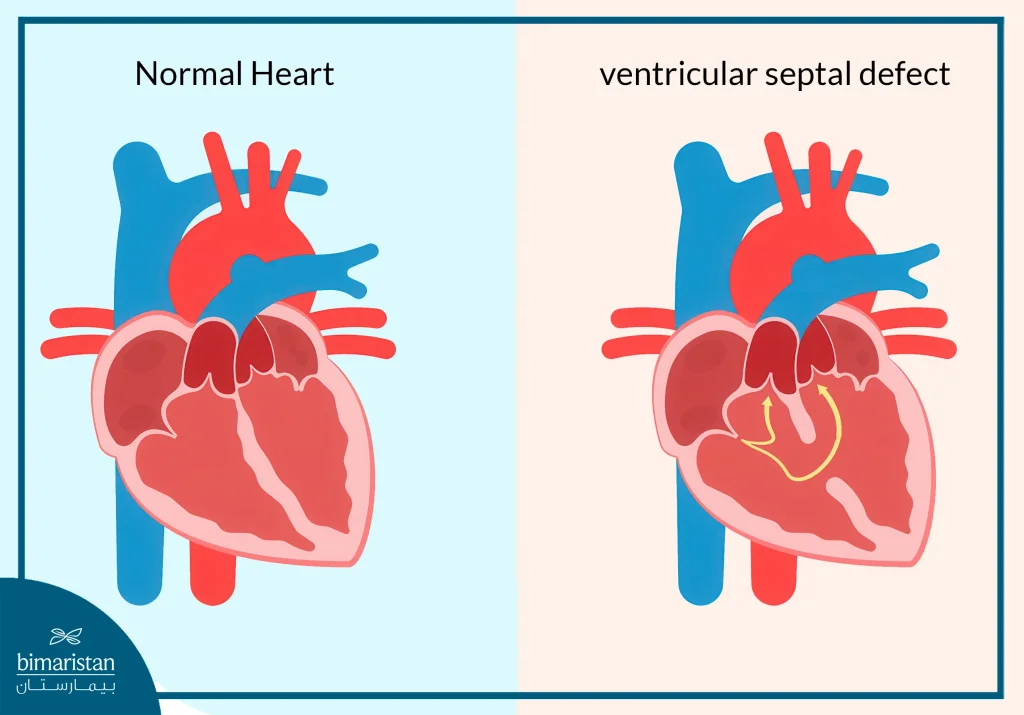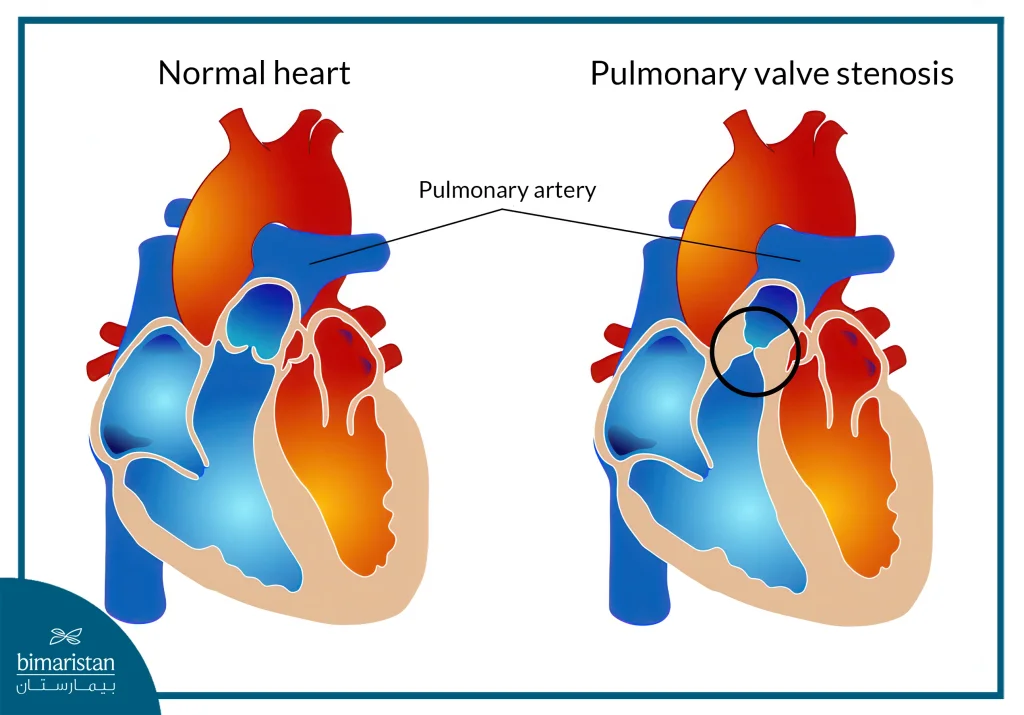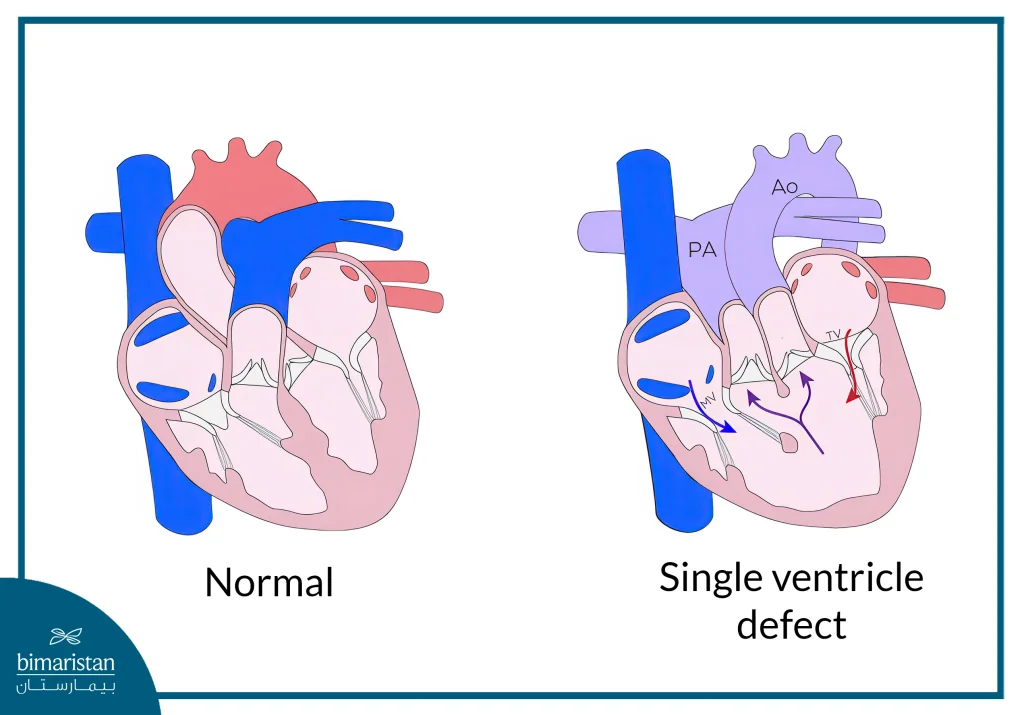Newborn congenital heart defects address one of the most common health issues facing newborns, ranging from simple cases that do not require medical intervention to complex ones that require multiple surgeries over a period of years. Early diagnosis and newborn congenital heart defect treatment can go a long way in improving their quality of life.
What are congenital heart defects in newborns?
Congenital heart defects, or congenital heart disease (CHD), are a major health issue as they are present from birth in the structure of the heart and are one of the most common birth defects, occurring in about 1% of live births. These abnormalities affect the normal flow of blood through the heart.
There are many types of congenital heart defects, the most common of which include defects in the inner walls of the heart, its valves, or the large blood vessels that carry blood to and from the heart. Some defects require minimal medical care, and others require urgent medical intervention after birth.
Although doctors don’t always know why these abnormalities occur, certain factors may increase the risk of giving birth to a baby with a heart condition, such as smoking, taking certain medications during pregnancy, and having a family history of these conditions. Congenital heart defects can usually be detected through symptoms, routine newborn screening, or prenatal testing. In some cases, careful cardiac tests may be required to diagnose the condition and plan the right newborn congenital heart defect treatment.
Methods of diagnosing and providing newborn congenital heart defect treatment have advanced significantly in recent years, so many children and adults with congenital heart defects may live normal lives or recover from them. By managing the condition regularly, paying attention to mental health, and monitoring symptoms, complications can be minimized, and quality of life can be greatly improved.
The difference between simple and complex cardiac abnormalities
Cardiac malformations are important health issues that affect the structure and function of the heart and can be categorized into two main types: Simple cardiac malformations and complex cardiac malformations, with each type differing significantly in terms of its impact on heart and body health.
Minor cardiac malformations refer to minor defects in the structure of the heart and often do not significantly affect blood flow or heart function. In most cases, children or adults with these abnormalities do not show any obvious symptoms, which makes their discovery happen by chance during routine examinations. These cases often do not require treatment but require periodic monitoring to ensure that the situation does not worsen. Examples of these abnormalities include a small hole in the heart wall or some types of heart valves that work normally despite the presence of a minor defect.
Complex cardiac malformations are more complex defects that significantly affect the blood flow and function of the heart, often present from birth, and may be accompanied by obvious symptoms such as difficulty breathing, cyanosis, or poor growth. Usually, these conditions require urgent medical intervention such as surgery. Common examples of these abnormalities include hypoplastic left heart syndrome or defects in large blood vessels, such as aortic stenosis.
How are heart abnormalities detected?
Congenital heart disease is a condition that can sometimes be diagnosed during pregnancy, but the diagnosis may not be confirmed until after birth.
Diagnosis during pregnancy
Congenital heart disease can be suspected during a routine fetal ultrasound scan. A specialized test known as Foetal Echocardiography is performed between 18 and 22 weeks of pregnancy to confirm an accurate diagnosis. This test is also recommended if there is a family history of congenital heart disease or if risk factors are present. However, it can be difficult to detect heart defects, especially minor ones, using fetal echocardiography.
Postpartum diagnosis
Congenital heart disease can sometimes be diagnosed in a baby right after birth if there are characteristic signs or symptoms such as blue skin or lips (cyanosis). The baby’s heart is examined as part of the newborn physical exam, which involves observing the baby, checking the pulse, and listening to the heart with a stethoscope. At this stage, heart murmurs may be detected. Some defects may not show noticeable symptoms for months or even years.
Consult your general practitioner if you notice signs of trouble.
Additional examinations
Several tests are used to diagnose congenital heart disease:
- Echocardiography: Commonly used to examine the inside of the heart, heart issues that were not noticed during a fetal echocardiogram can be detected as the child develops.
- Electrocardiogram (ECG): This test measures the electrical activity of the heart. Sticky sensors called electrodes are attached to your arms, legs, and chest and connected by wires to an ECG machine, which displays the electrical signals produced by your heart and shows how well your heart is beating.
- Chest X-ray: Used to determine if there is an increased amount of blood in the lungs or if the heart is larger than normal, both of which can be signs of heart disease.
- Pulse oximetry: Measures the amount of oxygen in your blood by placing a special sensor on your fingertip, ear, or toe. The sensor sends out light waves and connects to a computer that measures how the light waves are absorbed, allowing you to quickly determine the level of oxygen in your blood.
- Cardiac Catheterization: This is an effective way to get accurate information about how your heart pumps blood. A flexible tube called a catheter is inserted into a blood vessel, usually through an artery or vein in the groin, neck, or arm. The catheter is guided to the heart with the help of X-rays or sometimes an MRI machine. A colored dye that shows up on X-rays, known as angiography, can also be injected to study the movement of the dye through the heart and assess the shape and function of the heart chambers, blood vessels, and lungs. Cardiac catheterization is performed under general or local anesthesia, making it a painless procedure.
Types of congenital heart defects seen in newborns
Congenital heart defects encompass a variety of issues that affect the structure and function of the heart, which can lead to serious health complications. It is important to understand the different types of these defects and how they affect an individual’s health to help provide appropriate care and medical interventions when needed.
Atrial and ventricular septal defects
Atrial septal defect (ASD) is a hole in the wall between the left and right atria, the two upper chambers of the heart. This hole causes blood to flow from the left atrium to the right atrium instead of being directed to the rest of the body. This is considered a mild congenital heart defect, and the hole can close spontaneously as the heart develops in childhood. Surgical intervention may be required if the hole is large or if there are noticeable symptoms.
A ventricular septal defect (VSD) is a hole in the wall between the left and right ventricles, the lower chambers of the heart. The hole can cause oxygen-rich blood from the left ventricle to mix with oxygen-poor blood from the right ventricle, impeding blood flow to the rest of the body. If the hole is large, the heart and lungs will have to work harder to pump blood, which can cause fluid to build up in the lungs. Some cases require medical treatment or surgery to repair the defect.

Patent ductus arteriosus
Patent ductus arteriosus occurs when the connection between the heart’s two main arteries, the aorta and the pulmonary artery, doesn’t close properly after birth. This results in an opening that allows blood to flow in the wrong direction. Smaller openings can close on their own, but in larger cases may require treatment or surgery to repair, and the condition is more common in premature babies.
Pulmonary valve stenosis
Pulmonary valve stenosis is a type of heart valve disease in which the pulmonary valve becomes narrow or stiff, affecting the flow of blood from the heart to the pulmonary artery that connects the heart to the lungs. Stenosis can lead to increased pressure in the right ventricle, which can cause long-term complications. Most children with pulmonary valve stenosis do not require treatment, but some cases may require surgery to enlarge or replace the valve.

Fallow quadruple
Tetralogy of Fallot is one of the most common complex congenital heart disorders and consists of four major defects:
- Pulmonary valve stenosis: The pulmonary valve is narrowed, which affects the flow of blood to the lungs.
- Ventricular septal defect: A hole in the wall between the ventricles that causes the blood to mix.
- Bypassed aorta: In this condition, the aorta, which is responsible for transporting blood to the body, is misplaced, allowing oxygen-poor blood from the right ventricle to flow directly into the aorta instead of the pulmonary artery.
- Right ventricular hypertrophy: Occurs when the heart works harder than normal, causing the muscle of the right ventricle to thicken.
Tetralogy of Fallot requires urgent medical interventions and often corrective surgery to improve blood flow and ensure long-term heart health.
Other critical congenital heart defects
Critical congenital heart defects include additional types, such as:
- Aortic stenosis
- Double right ventricle
- Abnormal transposition of the great arteries
- Epstein’s deformity
- Hypoplastic left heart syndrome
- Aortic arch interruption
- Pulmonary artery embolism with intact ventricular septum
- Single ventricle

When does a newborn need urgent medical intervention?
Congenital heart defects are considered a critical medical condition that requires significant attention, as these defects can greatly affect the health and well-being of the newborn. In some cases, serious symptoms may occur that require urgent newborn congenital heart defect treatment, including:
- Symptoms of heart failure: There are clear signs requiring attention when a newborn has heart failure. The newborn may have difficulty breathing, rapid or intermittent breathing, and cyanotic lips or face, indicating low blood oxygen. If the newborn appears fatigued or is unable to nurse normally, this may indicate poor heart function, needing urgent medical evaluation.
- Changes in heartbeat: Abnormally fast or slow heartbeat may signal abnormal heart function, reducing blood pumping efficiency and requiring urgent newborn congenital heart defect treatment to stabilize the condition.
- Fluid accumulation: Swelling in the abdomen or legs, or rapid unexplained weight gain, can indicate fluid retention from poor heart function, which requires prompt medical attention to prevent complications.
- Symptoms of hypoxia: Pale or blue skin and unresponsiveness may indicate severe hypoxia, needing immediate newborn congenital heart defect treatment in an emergency setting.
- Feeding issues: Difficulty nursing or frequent vomiting after feeding can signal heart problems and require urgent medical evaluation.
- Signs of infection: A fever over 38°C or redness and swelling in specific areas may indicate infection, requiring fast medical attention, especially in newborns with congenital heart conditions.
Newborn congenital heart defect treatment
Newborn congenital heart defect treatment is a vital medical procedure that requires special attention, as these defects can significantly affect a child’s health and development. We will review some of the common heart defects and their treatment methods.
Patent ductus arteriosus (PDA) closure for the treatment of neonatal heart defects
The ductus arteriosus is an important blood vessel that connects the aorta and pulmonary artery before birth. If this duct does not close after birth, it is known as a patent ductus arteriosus, which requires treatment for neonatal heart defects.
In most cases, drug therapy is used to close the opening, but if that doesn’t work, there are other options. Ductus arteriosus closure can be performed without surgery by inserting a catheter through the femoral artery, where a special device is used to close the opening. In other cases, a minor surgery on the left side of the chest may be required to ligate the ductus, with an estimated success rate of 80-90% using either drug therapy or catheterization.
Structural heart defect repair for newborns: Congenital heart defect treatment
Congenital heart defects are considered a critical medical condition that requires significant attention, as these defects can greatly affect the health and well-being of the newborn. In some cases, serious symptoms may occur that require urgent newborn congenital heart defect treatment, including:
- Symptoms of heart failure: There are clear signs requiring attention when a newborn has heart failure. The newborn may have difficulty breathing, rapid or intermittent breathing, and cyanotic lips or face, indicating low blood oxygen. If the newborn appears fatigued or is unable to nurse normally, this may indicate poor heart function needing urgent medical evaluation.
- Changes in heartbeat: Abnormally fast or slow heartbeat may signal abnormal heart function, reducing blood pumping efficiency and requiring urgent newborn congenital heart defect treatment to stabilize the condition.
- Fluid accumulation: Swelling in the abdomen or legs, or rapid unexplained weight gain, can indicate fluid retention from poor heart function, which requires prompt medical attention to prevent complications.
- Symptoms of hypoxia: Pale or blue skin and unresponsiveness may indicate severe hypoxia, needing immediate newborn congenital heart defect treatment in an emergency setting.
- Feeding issues: Difficulty nursing or frequent vomiting after feeding can signal heart problems and require urgent medical evaluation.
- Signs of infection: A fever over 38°C or redness and swelling in specific areas may indicate infection, requiring fast medical attention, especially in newborns with congenital heart conditions.
Repairing complex heart defects to treat heart malformations in newborns
This category includes more complex defects that require immediate surgical intervention when treating neonatal heart defects
- Tetralogy of Fallot repair: Tetralogy of Fallot is a complex cardiac malformation that involves four major defects that affect normal blood flow. Treatment of this condition requires open-heart surgery where the hole in the ventricular septum is repaired and the thickened muscle is widened to improve blood flow to the lungs and body. Studies show a success rate of around 90%, reflecting the effectiveness of this procedure in treating these complex cardiac anomalies.
- Large vessel transposition repair: This condition occurs when the main arteries are connected backwards. Treatment of neonatal heart defects requires immediate surgery to correct this abnormality. Success rate: About 70-80% with early surgery.
- Stem artery repair: Stem artery condition is one of the rare defects that needs to be treated for heart defects in newborns. Treatment requires surgery to reroute the main arteries and close any existing defects. The success rate ranges from 60-80%, depending on the complexity of the condition.
Blood flow correction procedures to treat heart defects in newborns
These procedures relate to improving blood flow to the lungs or body as part of newborn congenital heart defect treatment when addressing heart defects in newborns.
- Tricuspid valve obstruction repair: This condition occurs when the valve is deformed or missing, affecting blood flow. Treatment of heart defects in newborns requires a series of surgical procedures to improve blood flow to the lungs. The success rate is about 70-80% in cases that require surgery.
- Correcting abnormal pulmonary vein return: This condition occurs when the pulmonary veins return to the wrong side of the heart. Treatment of neonatal heart defects requires surgery to reroute the veins to the correct side and close any abnormal connections. The success rate is 80-90% in appropriate cases.
- Repair of an incomplete left heart: This condition is one of the most severe defects requiring treatment of heart defects in newborns. It requires a series of surgeries where a new blood vessel is created to transport blood to the body and lungs. The success rate is about 70-80% with a series of surgeries.
Other surgical methods for newborn congenital heart defect treatment
- Heart transplant: A heart transplant can be used in certain situations such as a complex congenital heart defect that cannot be surgically repaired or if the heart fails after surgery. A heart transplant is a necessary option for children who are dependent on a ventilator or have severe symptoms of heart failure. Some adults with congenital heart defects may need a heart transplant later in life. Treating heart defects in newborns is a vital matter that requires quick decision-making.
- Palliative surgery: Palliative surgery is an option when newborns are too small or unable to tolerate heart surgery. These temporary procedures aim to improve oxygen levels in the blood before full surgery. The surgeon installs a tube known as a catheter, which creates an additional pathway for blood to travel to the lungs for oxygen. The shunt is later removed when the heart defects are repaired during the final operation. Treating heart defects in newborns requires careful planning to determine the right time for surgery.
- Ventricular Assistance Device (VAD): A VAD is a mechanical pump that enhances heart function and aids blood flow in people with a weak heart. The abnormal structure of the heart in cases of congenital heart defects can be a major challenge when using these devices, making the treatment of heart defects in newborns more complicated.
- A complete artificial heart: A complete artificial heart is an advanced solution that is surgically implanted to replace diseased or damaged ventricles. This device pumps blood to the lungs and other parts of the body, with external machines controlling the implanted pumps to ensure effective blood flow. In some cases, a complete artificial heart may be a more suitable option compared to a VAD. Treating heart defects in newborns opens up new horizons in the field of medicine, improving the quality of life for these patients.
Non-surgical interventions for newborn congenital heart defect treatment
- Medications: Medications are an effective way to treat neonatal heart defects such as patent ductus arteriosus. The ductus can close on its own, but sometimes medications are required to close it, especially in premature babies. Indomethacin and ibuprofen are among the medications used, as these drugs stimulate the narrowing of the patent ductus arteriosus, causing the opening to close. In some cases, acetaminophen is used as an additional option to achieve the same goal.
- Cardiac catheterization: Cardiac catheterization is a common medical procedure used to treat heart defects in newborns, such as atrial septal defect and patent ductus arteriosus, when these conditions do not improve spontaneously. Catheterization can be used to open heart valves or blood vessels that are too narrow. In cardiac catheterization, a thin, flexible tube known as a catheter is inserted into a blood vessel in the groin or neck and connected to the heart. You should be aware of the potential risks associated with this procedure, which include bleeding, infection, pain in the catheter insertion area, and possible damage to blood vessels.
Newborn congenital heart defect treatment is a complex process that requires specialized medical expertise. The goal of newborn congenital heart defect treatment is to improve children’s health and ensure their proper development. It is essential that these procedures are performed in specialized medical centers to ensure the best results.
Care after surgery or catheterization for newborn congenital heart defect treatment
Newborn congenital heart defect treatment is critical to ensure proper recovery. Here’s what parents should know about newborn congenital heart defect treatment:
- Constant monitoring: The baby’s vital signs, such as heart rate, blood pressure, and blood oxygen levels, should be monitored periodically. This helps detect early complications, allowing for rapid intervention if needed after newborn congenital heart defect treatment.
- Surgical care: Any surgical wounds or incisions should be checked for signs of infection like redness, swelling, or abnormal discharge. Keeping the wound clean and following medical instructions reduces infection risks after newborn congenital heart defect treatment.
- Nutrition: A doctor should be consulted about the appropriate diet after newborn congenital heart defect treatment. Special foods or supplements may be needed to promote healing and support heart health.
- Physical activity: Strenuous activities should be avoided for a set period after newborn congenital heart defect treatment. Always consult the doctor about when to resume normal activities; light activity can help, but must be supervised for safety.
- Regular medical visits: Routine follow-ups are essential to monitor the heart’s condition and ensure no complications arise after newborn congenital heart defect treatment, helping adjust treatment plans if needed.
Newborn congenital heart defect treatment is a path that requires a lot of care and attention. With early diagnosis and ongoing care, children’s chances of living a healthy and happy life can be improved. The support of parents and the medical team plays a key role in achieving positive outcomes through newborn congenital heart defect treatment, giving children and their families hope for a better future.
Sources:
- National Heart, Lung, and Blood Institute. (n.d.). Living with congenital heart defects. U.S. Department of Health and Human Services.
- MedlinePlus. (n.d.). Congenital heart defect – corrective surgery. U.S. National Library of Medicine. Retrieved May 28, 2025, from

